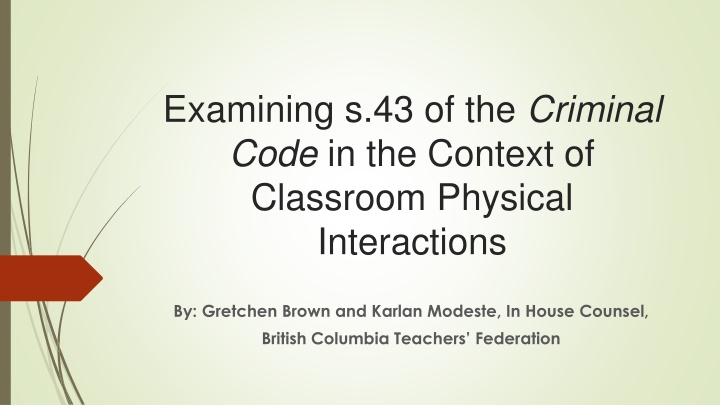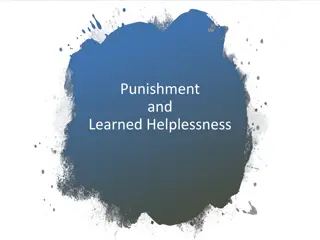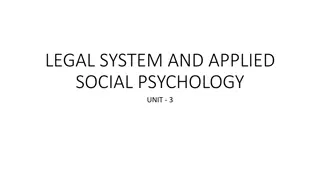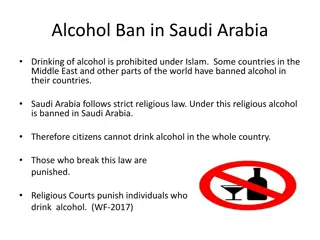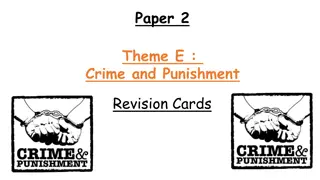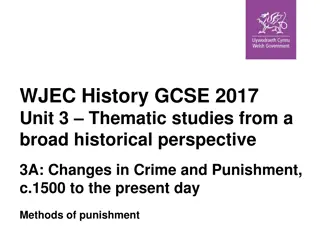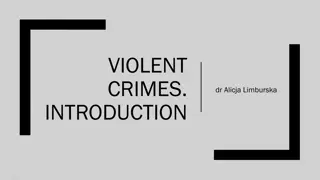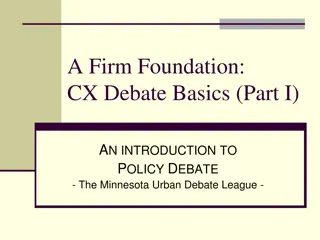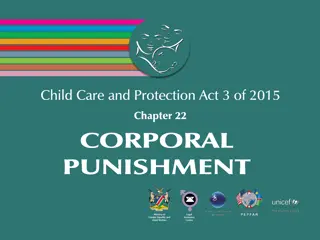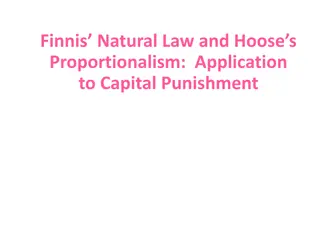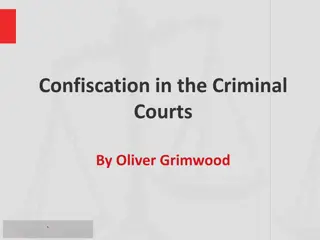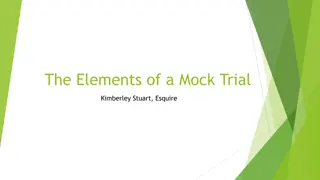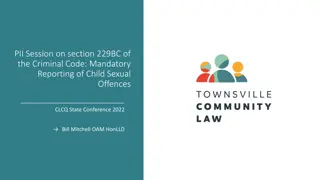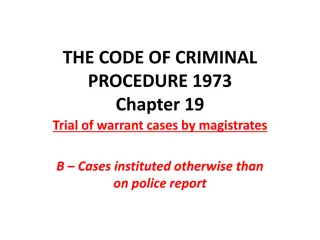Examining Section 43 of the Criminal Code: The Debate on Corporal Punishment in Schools
Section 43 of the Criminal Code, known as the "Spanking Law," justifies the use of force for correction by teachers, parents, or guardians towards children under their care. This provision has historical roots and has sparked debates on corporal punishment in schools globally. The article explores the history of section 43, its implications post a Supreme Court decision, and the shift towards abolishing it. It discusses the differing international perspectives on corporal punishment, highlighting countries that have banned it. The changing landscape in educational settings and the potential impact on teachers are also examined.
Download Presentation

Please find below an Image/Link to download the presentation.
The content on the website is provided AS IS for your information and personal use only. It may not be sold, licensed, or shared on other websites without obtaining consent from the author.If you encounter any issues during the download, it is possible that the publisher has removed the file from their server.
You are allowed to download the files provided on this website for personal or commercial use, subject to the condition that they are used lawfully. All files are the property of their respective owners.
The content on the website is provided AS IS for your information and personal use only. It may not be sold, licensed, or shared on other websites without obtaining consent from the author.
E N D
Presentation Transcript
Examining s.43 of the Criminal Code in the Context of Classroom Physical Interactions By: Gretchen Brown and Karlan Modeste, In House Counsel, British Columbia Teachers Federation
Examining s.43 of the Criminal Code in the Context of Classroom Physical Interactions Photo courtesy of Cornelia Naylor, The Burnaby NOW
Agenda History of section 43 and corporal punishment in schools 2004 Decision of Supreme Court of Canada Application of section 43 as a defense for teachers following SCC decision Relationship between criminal proceedings and regulatory proceedings Increased role of professional regulatory bodies Overall decrease in tolerance for physical methods of managing student behavior Movement to abolish section 43 Potential impact on teachers
Section 43 43. Every schoolteacher, parent or person standing in the place of a parent is justified in using force by way of correction toward a pupil or child, as the case may be, who is under his care, if the force does not exceed what is reasonable under the circumstances.
The Spanking Law Section 43 is sometimes referred to as the spanking law . It is known as the law which provides statutory authority for corporal punishment within homes and schools, but it is also the only Criminal Code provision that parents and teachers can rely on when defending the use of force to control or restrain children.
Historical Wording Original wording in the first criminal code of 1892: It is lawful for every parent, or person in the place of a parent, schoolmaster or master, to use force by way of correction towards any child, pupil or apprentice under his care, provided that such force is reasonable under the circumstances. reference to master and apprentice was removed in mid-1950s. only other changes have been minor rewordings, including replacing schoolmaster with school teacher .
Corporal Punishment in Schools - International Huge disparities in experience around the world Some countries banned corporal punishment many years ago for example: Finland, Norway, and Sweden USSR and China banned corporal punishment as part of initial post-revolution reforms Corporal punishment by teachers is still legal in many parts of the world Still a common occurrence in some countries where it is banned United States varies by state with some still permitting corporal punishment
US - Conflicting Trends Corporal punishment held constitutional in the 1977 Supreme Court case Ingraham v. Wright Banned in public schools in most northern states Still legal in most southern states Legal in almost all states for private schools Actively used in public schools in about 15 states In 2018, a public charter school in the US state of Georgia made the news when they introduced a corporal punishment policy which allowed paddling with parent consent Corporal punishment by teachers is expressly authorized by state law in Alabama. US news sources report that it is used on thousands of students in public schools across Alabama each year
Movement to Ban Corporal Punishment by Teachers - Canada 1971 Toronto Board of Education banned corporal punishment 1972 British Columbia passed legislation prohibiting corporal punishment
Debate around Changes in BC I cannot as Minister of Education in all consciousness, preside over a school system which condones and permits the use of corporal punishment on the children in the schools of British Columbia, Surely, Mr. Speaker, if we want to reduce acts of violence in our community and in the world, we must eliminate acts of violence in our schools. If we want to develop future generations into more humane people, we must practice more humanity ourselves. Eileen Dailly, then Minister of Education
Media Attention Talk-show hosts launched into an absolutely maniacal attack, Barrett recalled later, suggesting that normally placid children were turning in the classroom into wild animals who needed the strap to keep them in line. Confronted by intense criticism in public meetings, Barrett gave as good as he got, demanding in one Williams Lake showdown Why the hell we should use taxpayers money to beat your child? If you want your child beaten, do it on your time and at your expense. We will not be like free enterprise governments, we will not usurp parents responsibilities. As socialist, we don t believe the state has that right. But watch out. If you do beat your kid, you could get charged with abuse. The Art of the Impossible: Dave Barrett and the NDP in Power, 1972 1975.
British Columbia School Act Section 76 of the School Act : (1)All schools and Provincial schools must be conducted on strictly secular and non-sectarian principles. (2)The highest morality must be inculcated, but no religious dogma or creed is to be taught in a school or Provincial school. (3)The discipline of a student while attending an educational program made available by a board or a Provincial school must be similar to that of a kind, firm and judicious parent, but must not include corporal punishment.
Corporal Punishment in Canadian Schools Permitted until 2004 Other Canadian jurisdictions slow to follow Nova Scotia was next province to ban corporal punishment in 1989 Corporal punishment continued in some Canadian private schools until SCC decision in 2004
Canadian Foundation for Children, Youth and the Law v. Canada (Attorney General) In Canadian Foundation for Children, Youth and the Law v. Canada (Attorney General), the Supreme Court of Canada considered whether section 43 violates the Charter including section 7 (security of the person), section 12 (cruel and unusual punishment) and/or section 15 (equality rights). The court found that section 43 does not violate the Charter as it only protects force that is by way of correction and is reasonable under the circumstances . Canadian Foundation for Children, Youth and the Law v. Canada (Attorney General) [2004] 1 S.C.R. 76.
The Court Found: In considering what actions are consistent with this, the court narrowed the circumstances of when parents can use corrective force as follows: must have intended it to be for educative or corrective purposes cannot exculpate outbursts of violence against a child motivated by anger or animated by frustration child must be capable of benefiting from the correction Force against children under two cannot be corrective using objects, such as rulers or belts slaps or blows to the head will not be reasonable See paragraphs 23-37
With Respect to Teachers, the Court Found: teachers may sometimes use corrective force to remove children from classrooms or secure compliance with instructions, the use of corporal punishment by teachers is not acceptable. Paragraph 38
Consensus that Corporal Punishment by Teachers is not reasonable This consensus is consistent with Canada's international obligations, given the findings of the Human Rights Committee of the United Nations Expert evidence on harm caused by corporal punishment
What is reasonable under Section 43? Minor corrective force of a transitory and trifling nature It does not apply to corporal punishment of children under two or teenagers Degrading, inhuman or harmful conduct is not protected Discipline by the use of objects or blows or slaps to the head is unreasonable Teachers may reasonably apply force to remove a child from a classroom or secure compliance with instructions, but not merely as corporal punishment The conduct must be corrective, which rules out conduct stemming from the caregiver's frustration, loss of temper or abusive personality
Examples of Application of Section 43 to Teachers following SCC Decision R. v. Maddison involved an educational assistant working with a seven-year-old boy with ADHD and Oppositional Defiance Disorder. The boy was very physically aggressive with teachers and other students. On a number of occasions, Maddison physically restrained and moved the boy. Other educational assistants alleged that she did so in an unreasonably rough manner. The court acquitted Maddison on the basis that section 43 applied. The court found that there was a conflict between Maddison and her colleagues which called into question their perception of her conduct
R. v. Jonkman R.v. Jonkman, a 2010 Alberta case, concerned a substitute teacher who was called in to teach a grade 6 class. A number of students were behaving rudely. Jonkman was charged and convicted of assault for grabbing a student by his arm and pulling him from his desk. The court found that the behaviour was motivated by anger and frustration. The court rejected both the section 43 defence as well as the defence of de minimus .
R. v. Burtis R. v. Burtis also involved a substitute teacher. Burtis was working in a kindergarten class. She was charged with assault in relation to her interactions with a five-year-old boy who had severe autism. After the boy repeatedly touched the ears of other students, Burtis pinched his ears multiple times and asked, How would you like it if your friends did that to you? In convicting her of assault, the court did not accept her denial of the allegations and found that her behaviour showed a loss of control.
Judicial Approach to Applying Section 43 to Teachers post-2004 Focus on: - Nature and purpose of physical interactions - Whether student was harmed - Reasonableness of teacher conduct - Teachers only acquitted where physical contact was very minimal
Decline in Number of Reported Cases Involving Teachers Many criminal decisions not published Section 43 may deter police and prosecutors from proceeding with charges
Expanding Role of Professional Regulation While criminal cases involving teachers charged with assault appear to have declined, there has been an increase in employer and regulator investigation and discipline of teachers. Harsh public discipline of teachers by regulators may deter police and prosecutors from proceeding with criminal charges unless allegations are very serious. The Pattern in BC - Increase in police investigations relating to cases where there are relationship boundary issues. Less police investigations into physical interactions. - Allegations of minor physical allegations dealt with by employers and the Teacher Regulation Branch
BC Teacher Regulation Branch Decisions Involving Physical Interactions with Students In 2018, the British Columbia Teacher Regulation Branch ( TRB ) reported six Consent Resolution Agreements ( CRA ) where teachers were held to have used physical force against students.
Examples of the TRB Approach In Caswell, a teacher with 6 years of experience approached a student from behind and put her hand over the student s mouth and nose area while telling the student to shut up. The TRB issued a two-day suspension and a requirement to complete a course, Creating a Positive Learning Environment .
Examples of the TRB Approach In Zhang, a teacher with 10 years of experience grabbed a student tightly by the arm and pulled him off of a riser, causing the student s foot to be caught between two risers. The teacher then pushed the student out of the classroom. The TRB issued a two-day suspension of his certificate and the completion of the course The Mindful Educator in Managing Conflict .
Multiple Allegations Physical and Non-physical Misconduct In Lee , a teacher with 13 years of experience grabbed a student s hand while she was typing because she was not following his instructions. In other incidents, the teacher tackled a student during a no- contact game of handball, grabbed a boy s finger and pointed it towards the desk when the student seemed confused about an assignment, and grabbed a student s head during a safety demonstration about cycling. The teacher also threw erasers, masking tape and balls at students as a form of punishment, and made inappropriate comments to students, yelled and demonstrated anger towards students. The TRB issued a four-month suspension of his certificate.
Ontario College of Teachers In 2018, the Ontario College of Teachers (the College ) issued 9 decisions that involved a teacher s use of physical force against a student. In Hutton, a teacher with 42 years of experience grabbed a student s leg, causing him to fall after the student ran at the teacher. The teacher had also made inappropriate comments to students. The Children s Aid Society of Hamilton (the CAS ) investigated this matter and found a risk of physical and emotional harm. The College issued a reprimand and a course requirement in classroom instruction.
Varied Allegations In Steele , the teacher threw objects in the direction of students and kicked furniture, which caused injuries to students. In addition, the teacher yelled and made inappropriate comments to students. In an unrelated incident, the teacher was charged and convicted of two counts of assault for a domestic incident. The teacher received a two-year suspension of his certificate, and a course completion requirement in classroom management.
Professional Regulatory vs. Criminal Proceedings Lower bar for what kind conduct warrants sanction Broader scope of inquiry More allegations in one proceeding Lower standard of proof Less procedural protections Regulators have very expansive investigative powers Limited judicial review Outcomes are consistently public and likely to receive media coverage
Section 43 Becoming Less Relevant for Teachers? Declining number of criminal cases involving teachers using physical force Allegations of physical contact increasingly dealt with by regulators rather than police and courts
Movement to Abolish Section 43 Since the 1990s, there has been periodic initiatives at the Senate level to introduce legislation to abolish section 43 2008 Bill S-209 was passed by the Senate and set for first reading by the House of Commons but was not pursed after parliament was dissolved At that time, teacher organizations were concerned that teachers might be left without adequate protection from assault charges
Abolish or Amend? Amendments could expressly prohibit corporal punishment but provide a defense for reasonable use of physical force to protect children from harm and manage their behaviour.
Recent Efforts Bill S-206 removes section 43 Second reading in Senate on May 31, 2018 Referred to Senate Legal Affairs Committee Unclear whether it will be pursued further
The Truth and Reconciliation Commission In order to redress the legacy of residential schools and advance the process of Canadian reconciliation, the Truth and Reconciliation Commission makes the following call to action: We call upon the Government of Canada to repeal Section 43 of the Criminal Code of Canada.
Impact of TRC on Debate Increased political support for abolishing section 43 Commitment from the Trudeau government to implement the recommendation Nature of historical abuses included not only corporal punishment by also restraint and enforcement of unreasonable and abusive directions. This has an impact on the abolish vs amend debate
Consequences of Keeping Section 43 in Current Form Inconsistent with current societal expectations Not responsive to Truth and Reconciliation Commission Inconsistent with international commitments on the rights of children Misleading for parents and teachers
Risks of Repealing Very broad definition of assault in the Criminal Code: 265 (1) A person commits an assault when (a) without the consent of another person, he applies force intentionally to that other person, directly or indirectly; (b) he attempts or threatens, by an act or a gesture, to apply force to another person, if he has, or causes that other person to believe on reasonable grounds that he has, present ability to effect his purpose
Alternative Defenses for Teachers Implied consent Necessity De minimis
Examples from Healthcare Sector Health care workers do not have an express defense to assault in criminal code Courts have applied common law defenses Courts look to provincial legislation and professional guidelines when assessing reasonableness of physical interactions
BC Ministry of Education Guidelines Physical restraint or seclusion is used only in exceptional circumstances where the behaviour of a student poses imminent danger of serious physical harm to self or others, including school personnel, and where less restrictive interventions have been ineffective in ending imminent danger of serious physical harm. Restraint or seclusion is discontinued once imminent danger or serious physical self-harm or harm to others has dissipated. Neither restraint nor seclusion are used as a punishment, discipline, or to force compliance in an educational/learning setting
Conclusions Value of section 43 as a defense for teachers has diminished Practical consequences of abolishing section 43 limited Beyond the criminal context very little toleration of physical interactions with students Harsh sanctions from employers and regulators
